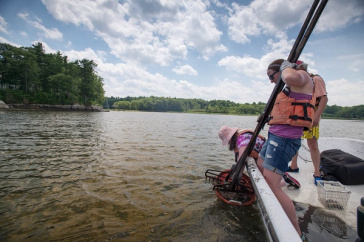The University of New Hampshire is a flagship research university that inspires innovation and transforms lives in our state, nation and world. More than 16,000 students from all 50 states and 71 countries engage with an award-winning faculty in top ranked programs in business, engineering, law, health and human services, liberal arts and the sciences across more than 200 programs of study. UNH’s research portfolio includes partnerships with NASA, NOAA, NSF and NIH, receiving more than $100 million in competitive external funding every year to further explore and define the frontiers of land, sea and space.
UNH Researchers Work to Predict Bacteria Outbreaks in Great Bay Oysters

In the Great Bay Estuary, a team of undergraduate and graduate students collect oysters to look at environmental conditions that might favor V. parahaemolyticus.
DURHAM, N.H. – University of New Hampshire scientists are close to being able to predict when oysters in New Hampshire’s Great Bay Estuary may be at risk of being infected with a bacteria that has sickened consumers throughout the Northeast.
In a paper published in the journal PLOS ONE, the researchers describe the development of a predictive modeling tool capable of estimating the likelihood of Vibrio parahaemolyticus presence in coastal New Hampshire oysters. V. parahaemolyticus is the most common bacterial infection acquired from seafood in the world. There are an estimated 45,000 cases each year in the United States. In recent years, there has been an increase in the incidence of shellfish contamination. Some strains of the microbe cause disease and others do not.
“This research represents a significant advance in our understanding of what environmental conditions are related to the incidence of V. parahaemolyticus, a human pathogenic bacterium, in New Hampshire oysters,” said Stephen Jones, research associate professor of natural resources and one of the scientists involved with the study. “We found that not only water temperature and salinity are important, but also chlorophyll, which is a measure of how much phytoplankton biomass is present in the water overlying natural oyster beds.”
UNH researchers have been tracking Vibrios in the Great Bay Estuary for 10 consecutive years, and previously in the 1990s and 2000s. In the 1980s, UNH scientists were the first to detect Vibrio vulnificus – a potentially more serious species of Vibrio – in the Great Bay estuary. In a major breakthrough in shellfish management and disease prevention, in 2015 UNH scientists announced they discovered a new method to detect the specific strains that cause human illness in New England oyster beds. The new patent-pending detection method is a significant advance. This latest research represents an initial step to study Vibrio populations at this more detailed scale within a shellfish harvest area-sized study area to help inform larger regional efforts to develop risk forecasting tools for the region.
“In the last five years, V. parahaemolyticus has become an increasingly significant pathogen to humans who consume raw or undercooked shellfish in the Northeast United States,” Jones said. “Where in the past cases of illness were quite rare, there have now been outbreaks of illness caused by this species in Long Island Sound and the southern Gulf of Maine in Massachusetts. In New Hampshire, there has yet to be a reported case of illness from this pathogen associated with shellfish consumption, but our collective studies at UNH are tracking how its presence is changing in New Hampshire coastal waters and shellfish.”
The researchers present their findings in “Environmental Conditions Associated with Elevated Vibrio parahaemolyticus Concentrations in Great Bay Estuary, New Hampshire,” in PLOS ONE. In addition to Jones, who also is associate director of NH Sea Grant, researchers involved in this study include Erin Urquhart with the Northeast Center for Vibrio Disease and Ecology at UNH and a former postdoctoral researcher with the UNH Department of Molecular, Cellular, and Biomedical Sciences; Jong Yu, Brian Schuster, and Ashley Marcinkienwicz with the Northeast Center for Vibrio Disease and Ecology at UNH; Cheryl Whistler, associate professor of molecular, cellular, and biomedical sciences at UNH and the Northeast Center for Vibrio Disease and Ecology at UNH; and Vaughn Cooper, affiliate faculty member with UNH Department of Molecular, Cellular, and Biomedical Sciences and associate professor of microbiology and molecular genetics at the University of Pittsburgh. Whistler and Jones also are researchers with the NH Agricultural Experiment Station.
This material is based upon work supported by the NH Agricultural Experiment Station, through joint funding of the National Institute of Food and Agriculture, U.S. Department of Agriculture, under award numbers 233555 and 1004199, and the state of New Hampshire. This work also is supported by funding from the National Science Foundation EPSCoR Program and New Hampshire Sea Grant College Program.
Founded in 1887, the NH Agricultural Experiment Station at the UNH College of Life Sciences and Agriculture is UNH’s original research center and an elemental component of New Hampshire's land-grant university heritage and mission.
Latest News
-
November 26, 2025
-
November 6, 2025
-
November 5, 2025
-
October 24, 2025
-
October 8, 2025














































